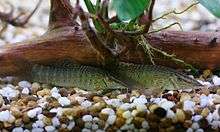Syncrossus beauforti
Synocrossus beauforti, the barred loach,chameleon loach or chameleon botia, is a species of freshwater fish from the loach family Botiidae which is found in mainland south-east Asia.
| Syncrossus beauforti | |
|---|---|
 | |
| Scientific classification | |
| Kingdom: | Animalia |
| Phylum: | Chordata |
| Class: | Actinopterygii |
| Order: | Cypriniformes |
| Family: | Botiidae |
| Genus: | Syncrossus |
| Species: | S. beauforti |
| Binomial name | |
| Syncrossus beauforti (Smith, 1931) | |
| Synonyms[2] | |
| |
Description
Syncrossus beauforti resembles Syncrossus berdmorei but has 11-14 dorsal fin rays as opposed to 9-10 in S. berdmorei. Tn both species there are rows of small, dark spots running along the length of the body and the head, but in S. beauforti these markings are a slightly smaller and it has 9-12 faint vertical bars on its body. As the fish matures bars may fade leaving the longitudinal rows of dark markings. The dorsal fin has a black margin and 3 rows of spots, while the caudal fin has several vertical rows of spots. When excited, these fish are able to produce clicking sounds.[3] They grow to a maximum length of 25 cm standard length.[4]
Distribution
Syncrossus beauforti is found in south-east Asia and the species was originally described from specimens taken in a stream in Nakhon Si Thammarat Province in southern Thailand and was then recorded in Trang Province and has now been found to occur in the basin of the Salween River on the borders between Thailand and Myanmar and the Chao Phraya River system in western and central Thailand. Records from the Mekong are now attributed to two separate species, S, yunnanensis and S. formosanus[5] which may be synonyms of Syncrossus lucasbahi.[6]
Habitat and Ecology
Syncrossus beauforti occurs in the demersal zone of small and medium-sized rivers and it is habitually associated with streams which clear and fast flowing with a stony or rocky substrate,[1] with large amounts of wood debris and leaf litter.[5] It may enter flooded forest during the high-water periods during the monsoon and returns to the rivers during November and December. It digs burrows in sand or excavates them under rocks.[1] It is omnivorous with the bulk of its diet being made up of insect larvae and benthic animals.[3] Species in the genus Syncrossus are sociable and are known to form dominance hierarchies within social groups and to undertake ritualised behaviours to determine their place in the hierarchy. These fish possess sharp sub-ocular spines which they can move, these are normally hidden inside a pouch of skin but when the fish is stressed it can erect these spines. In addition they make sounds when excited but the purpose of the sounds is unknown.[5]
Human Use and Conservation
Syncrossus beauforti is sometimes recorded in fish markets being sold for human consumption. It is an aquarium fish but it has not been known to have been bred in captivity so all of the individuals traded are assumed to have been caught in the wild. The taking of specimens for this trade appears to be the principal threat to this species.[1] It is also threatened by pollution and by the damming of the rivers it occurs in which may prevent the fish from migrating to its spawning areas during the periods of flooding, as well as increasing sedimentation and causing habitat degradation. The population is thought to be decreasing but the population size and extent of the decline is unknown.[1]
References
- Jenkins, A., Kullander, F.F. & Tan, H.H. (2009). "Syncrossus beauforti". IUCN Red List of Threatened Species. 2009: e.T169503A6639271. doi:10.2305/IUCN.UK.2009-2.RLTS.T169503A6639271.en.CS1 maint: multiple names: authors list (link)
- "Synonyms of Syncrossus beauforti (Smith, 1931)". Fishbase. Retrieved 19 August 2017.
- "Syncrossus beauforti - Chameleon Loach". Diszhal.info. Retrieved 19 August 2017.
- R. Froese; D. Pauly, eds. (2017). "Syncrossus beauforti (Smith, 1931) Chameleon loach". Fishbase. Retrieved 19 August 2017.
- "Species Profile Syncrossus beauforti (Smith, 1931)". Seriously Fish. Retrieved 19 August 2017.
- Kottelat, M. (2012): Conspectus cobitidum: an inventory of the loaches of the world (Teleostei: Cypriniformes: Cobitoidei). Archived February 11, 2013, at the Wayback Machine The Raffles Bulletin of Zoology, Supplement No. 26: 1-199.
